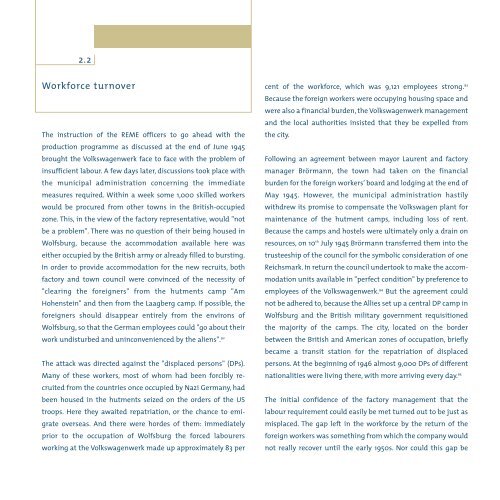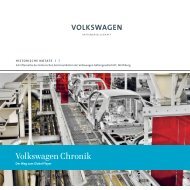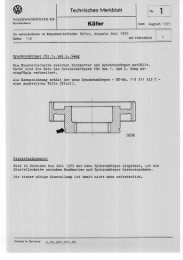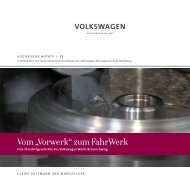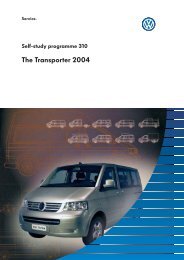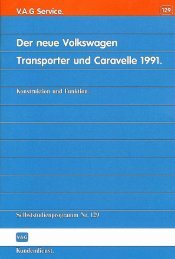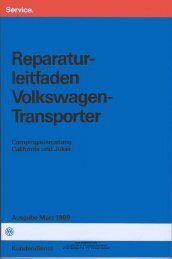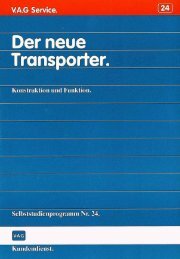HN 2: The British and their Works
HN 2: The British and their Works
HN 2: The British and their Works
You also want an ePaper? Increase the reach of your titles
YUMPU automatically turns print PDFs into web optimized ePapers that Google loves.
2.2<br />
Workforce turnover<br />
<strong>The</strong> instruction of the REME officers to go ahead with the<br />
production programme as discussed at the end of June 1945<br />
brought the Volkswagenwerk face to face with the problem of<br />
insufficient labour. A few days later, discussions took place with<br />
the municipal administration concerning the immediate<br />
measures required. Within a week some 1,000 skilled workers<br />
would be procured from other towns in the <strong>British</strong>-occupied<br />
zone. This, in the view of the factory representative, would "not<br />
be a problem". <strong>The</strong>re was no question of <strong>their</strong> being housed in<br />
Wolfsburg, because the accommodation available here was<br />
either occupied by the <strong>British</strong> army or already filled to bursting.<br />
In order to provide accommodation for the new recruits, both<br />
factory <strong>and</strong> town council were convinced of the necessity of<br />
"clearing the foreigners" from the hutments camp "Am<br />
Hohenstein" <strong>and</strong> then from the Laagberg camp. If possible, the<br />
foreigners should disappear entirely from the environs of<br />
Wolfsburg, so that the German employees could "go about <strong>their</strong><br />
work undisturbed <strong>and</strong> uninconvenienced by the aliens". 92<br />
<strong>The</strong> attack was directed against the "displaced persons" (DPs).<br />
Many of these workers, most of whom had been forcibly recruited<br />
from the countries once occupied by Nazi Germany, had<br />
been housed in the hutments seized on the orders of the US<br />
troops. Here they awaited repatriation, or the chance to emigrate<br />
overseas. And there were hordes of them: immediately<br />
prior to the occupation of Wolfsburg the forced labourers<br />
working at the Volkswagenwerk made up approximately 83 per<br />
cent of the workforce, which was 9,121 employees strong. 93<br />
Because the foreign workers were occupying housing space <strong>and</strong><br />
were also a financial burden, the Volkswagenwerk management<br />
<strong>and</strong> the local authorities insisted that they be expelled from<br />
the city.<br />
Following an agreement between mayor Laurent <strong>and</strong> factory<br />
manager Brörmann, the town had taken on the financial<br />
burden for the foreign workers’ board <strong>and</strong> lodging at the end of<br />
May 1945. However, the municipal administration hastily<br />
withdrew its promise to compensate the Volkswagen plant for<br />
maintenance of the hutment camps, including loss of rent.<br />
Because the camps <strong>and</strong> hostels were ultimately only a drain on<br />
resources, on 10th July 1945 Brörmann transferred them into the<br />
trusteeship of the council for the symbolic consideration of one<br />
Reichsmark. In return the council undertook to make the accommodation<br />
units available in "perfect condition" by preference to<br />
employees of the Volkswagenwerk. 94 But the agreement could<br />
not be adhered to, because the Allies set up a central DP camp in<br />
Wolfsburg <strong>and</strong> the <strong>British</strong> military government requisitioned<br />
the majority of the camps. <strong>The</strong> city, located on the border<br />
between the <strong>British</strong> <strong>and</strong> American zones of occupation, briefly<br />
became a transit station for the repatriation of displaced<br />
persons. At the beginning of 1946 almost 9,000 DPs of different<br />
nationalities were living there, with more arriving every day. 95<br />
<strong>The</strong> initial confidence of the factory management that the<br />
labour requirement could easily be met turned out to be just as<br />
misplaced. <strong>The</strong> gap left in the workforce by the return of the<br />
foreign workers was something from which the company would<br />
not really recover until the early 1950s. Nor could this gap be


